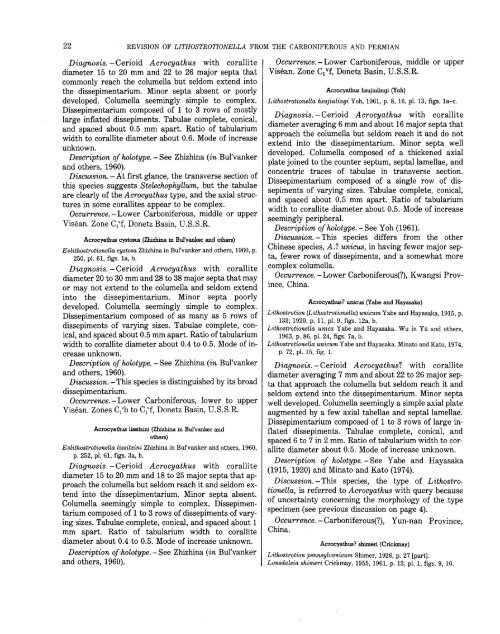Revision of Lithostrotionella - USGS
Revision of Lithostrotionella - USGS
Revision of Lithostrotionella - USGS
You also want an ePaper? Increase the reach of your titles
YUMPU automatically turns print PDFs into web optimized ePapers that Google loves.
22 REVISION OF LITHOSTROTIONELLA FROM THE CARBONIFEROUS AND PERMIAN<br />
Diagnosis.- Cerioid Acrocyathus with corallite<br />
diameter 15 to 20 mm and 22 to 26 major septa that<br />
commonly reach the columella but seldom extend into<br />
the dissepimentarium. Minor septa absent or poorly<br />
developed. Columella seemingly simple to complex.<br />
Dissepimentarium composed <strong>of</strong> 1 to 3 rows <strong>of</strong> mostly<br />
large inflated dissepiments. Tabulae complete, conical,<br />
and spaced about 0.5 mm apart. Ratio <strong>of</strong> tabularium<br />
width to corallite diameter about 0.6. Mode <strong>of</strong> increase<br />
unknown.<br />
Description <strong>of</strong> holotype. -See Zhizhina (in Bul'vanker<br />
and others, 1960).<br />
Discussion. -At first glance, the transverse section <strong>of</strong><br />
this species suggests Stelechophyllum, but the tabulae<br />
are clearly <strong>of</strong> the Acrocyathus type, and the axial structures<br />
in some corallites appear to be complex.<br />
Occurrence. -Lower Carboniferous, middle or upper<br />
Visean. Zone C 1 vf, Donetz Basin, U.S.S.R.<br />
Acrocyathus cystosus (Zhizhina in Bul'vanker and others)<br />
Eolithostrotionella cystosa Zhizhina in Bul'vanker and others, 1960, p.<br />
250, pl. 61, figs. la, b.<br />
Diagnosis.- Cerioid Acrocyathus with corallite<br />
diameter 20 to 30 mm and 28 to 38 major septa that may<br />
or may not extend to the columella and seldom extend<br />
into the dissepimentarium. Minor septa poorly<br />
developed. Columella seemingly simple to complex.<br />
Dissepimentarium composed <strong>of</strong> as many as 5 rows <strong>of</strong><br />
dissepiments <strong>of</strong> varying sizes. Tabulae complete, conical,<br />
and spaced about 0.5 mm apart. Ratio <strong>of</strong>tabularium<br />
width to corallite diameter about 0.4 to 0.5. Mode <strong>of</strong> increase<br />
unknown.<br />
Description <strong>of</strong> holotype. - See Zhizhina (in Bul'vanker<br />
and others, 1960).<br />
Discussion. -This species is distinguished by its broad<br />
dissepimentarium.<br />
Occurrence.- Lower Carboniferous, lower to upper.<br />
Visean. Zones C 1<br />
vb to C 1<br />
vf, Donetz Basin, U.S.S.R.<br />
Acrocyathus lissitzini (Zhizhina in Bul'vanker and<br />
others)<br />
Eolithostrotionella lissitzini Zhizhina in Bul'vanker and others, 1960,<br />
p. 252, pl. 61, figs. 3a, b.<br />
Diagnosis.- Cerioid Acrocyathus with corallite<br />
diameter 15 to 20 mm and 18 to 25 major septa that approach<br />
the columella but seldom reach it and seldom extend<br />
into the dissepimentarium. Minor septa absent.<br />
Columella seemingly simple to complex. Dissepimentarium<br />
composed <strong>of</strong> 1 to 3 rows <strong>of</strong> dissepiments <strong>of</strong> varying<br />
sizes. Tabulae complete, conical, and spaced about 1<br />
mm apart. Ratio <strong>of</strong> tabularium width to corallite<br />
diameter about 0.4 to 0.5. Mode <strong>of</strong> increase unknown.<br />
Description <strong>of</strong>:holotype. -See Zhizhina (in Bul'vanker<br />
and others, 1960),.<br />
Occurrence. -Lower Carboniferous, middle or upper<br />
Visean. Zone C 1 vf, Donetz Basin, U.S.S.R.<br />
Acrocyathus hsujiulingi (Yoh)<br />
<strong>Lithostrotionella</strong> hsujiulingi Yoh, 1961, p. 8, 16, pl. 13, figs. la-c.<br />
Diagnosis.- Cerioid Acrocyathus with corallite<br />
diameter averaging 6 mm and about 16 major septa that<br />
approach the columella but seldom reach it and do not<br />
extend into the dissepimentarium. Minor septa well<br />
developed. Columella composed <strong>of</strong> a thickened axial<br />
plate joined to the counter septum, septal lamellae, and<br />
concentric traces <strong>of</strong> tabulae in transverse section.<br />
Dissepimentarium composed <strong>of</strong> a single row <strong>of</strong> dissepiments<br />
<strong>of</strong> varying sizes. Tabulae complete, conical,<br />
and spaced about 0.5 mm apart. Ratio <strong>of</strong> tabularium<br />
width to corallite diameter about 0.5. Mode <strong>of</strong> increase<br />
seemingly peripheral.<br />
Description <strong>of</strong> holotype.- See Yoh (1961).<br />
Discussion. -This species differs from the other<br />
Chinese species, A.? unicus, in having fewer major septa,<br />
fewer rows <strong>of</strong> dissepiments, and a somewhat more<br />
complex columella.<br />
Occurrence. -Lower Carboniferous(?), Kwangsi Province,<br />
China.<br />
Acrocyathus? unicus (Y abe and Hayasaka)<br />
Lithostrotion (<strong>Lithostrotionella</strong>) unicum Yabe and Hayasaka, 1915, p.<br />
133; 1920, p. 11, pl. 9, figs. 12a, b.<br />
<strong>Lithostrotionella</strong> unica Yabe and Hayasaka. Wu in Yii and others,<br />
1963, p. 86, pl. 24, figs. 7a, b.<br />
<strong>Lithostrotionella</strong> unicum Yabe and Hayasaka. Minato and Kato, 197 4,<br />
p. 72, pl. 15, fig. 1.<br />
Diagnosis. - Cerioid Acrocyathus? with corallite<br />
diameter averaging 7 mm and about 22 to 26 major septa<br />
that approach the columella but seldom reaeh it and<br />
seldom extend into the dissepimentarium. Minor septa<br />
well developed. Columella seemingly a simple axial plate<br />
augmented by a few axial tabellae and septal ]ameBae.<br />
Dissepimentarium composed <strong>of</strong> 1 to 3 rows <strong>of</strong> large inflated<br />
dissepiments. Tabulae complete, conical, and<br />
spaced 6 to 7 in 2 mm. Ratio <strong>of</strong> tabularium width to corallite<br />
diameter about 0.5. Mode <strong>of</strong> increase unknown.<br />
Description <strong>of</strong> holotype. -See Y abe and Hayasaka<br />
(1915, 1920) and Minato and Kato (1974).<br />
Discussion. -This species, the type <strong>of</strong> <strong>Lithostrotionella</strong>,<br />
is referred to Acrocyathus with query because<br />
<strong>of</strong> uncertainty concerning the morphology <strong>of</strong> the type<br />
specimen (see previous discussion on page 4).<br />
Occurrence.- Carboniferous(?), Yun-nan Province,<br />
China.<br />
Acrocyathus? shimeri (Crickmay)<br />
Lithostrotion pennsylvanicum Shimer, 1926, p. 27 [part].<br />
Lonsdaleia shimeri Crickmay, 1955, 1961, p. 13, pl. 1, figs. 9, 10.

















